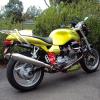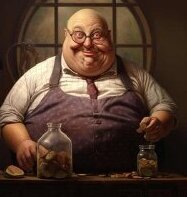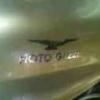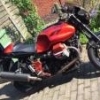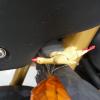Leaderboard
Popular Content
Showing content with the highest reputation on 02/15/2021 in Posts
-
The 'Rule of thumb' for bearing clearance is one thou for every inch of journal diameter. If you're building a commuter engine that is just going to potter you make the clearance towards the smaller end of tolerance, for something that is going to be thrashed mercilessly and produce as much power as possible you go for the larger end of the clearance envelope. The oil may not have as strong a wedge but the greater oil throughput will cool the bearing better. Mr. Finnegan has an excellent reputation but I agree with Phil, it's all 'Old School' stuff. I find myself frustrated by people who still believe that Phil Irving's 'Tuning for Speed' is the ad-ultra of tuning theory. It's an interesting book, but it was written seventy years ago and oddly enough, things have changed. The old Guzzi 2 Valve is a 1950's design so yes, it will respond to 1950's tuning methods, but there's nothing 'New' in any of this stuff.5 points
-
Was thinking more along this line. Made here in Australia. Monocoque aluminium chassis, Chev LS or Ford twin cam V8 engine. Fully independent bespoke suspension, billet A arms carbon fibre body thats so good many order with polished gelcoat coloured finish and don't bother with paint. No donor stuff apart from the engine transmission and the diff centre. Ciao3 points
-
So little action here re Aussie roads. I have so few electronic images of riding, most are old printed stuff. Here's a few from more recent times although a bit boring. This is a fairly large water reservoir near home that I visit often as it's on one of my usual country rides. I like to keep an eye on it's condition as its one of the main water supplies for Melbourne. I've seen it looking dismal and beautiful over the years depending on its level. There is a sailing club and a couple of picnic areas around it and a very nice 18 klm long open bushland walk around its perimeter which the wife and I have done quite a few time. Out there is total quiet except for the birds most of the times. Here's the Guzzi parked there a few years ago. My old ST2 parked at one of the picnic areas. Here's a shot I got there on a very still day. Very reflective mood. A trip into the city a few years ago to have lunch with my wife. A Sunday at my local hill climb about 10 min from home. The end of my street. 30 min drive from the heart of Melbourne. Ciao3 points
-
I know the feeling... even though I have one now.. I always regretted selling my first one that I bought new. Even though I’ve had some very fine machines in between.. The V11 was special to me. The only bike that came close was my ‘05 999R Maybe it’s my preference for twins, but that was also a very well (and sadly a sales loser) put together machine. My Scura will be pried out of my cold dead hands....3 points
-
On my white face Veglia's on a 2001 Mandello Rosso (black frame, short frame) it spins cw to release. It is left-hand thread. I know this because I actually had to remove it yesterday2 points
-
At 7:30 it turned into bench racing session with this guy said his bike would beat this other bike. Why do people seem impressed when someone applies 50 year old tuning technology to a 50 year old engine. They have been using D shaped ports forever on big 2 valve engines for years with large included valve angles (pretty much all of them) nothing amazing there. As for 0.002" way ahead of their time big end clearances well. There hasn't been any changes to engine bearing or piston clearances in 50 years I can think of. I can put any engine in the last 50 years together with .0015 to .002" big end clearance and .002 on the main bearings and it will work fine. What has changed is the ability of manufacturers to more consistently produce those tolerances and avoid selective assembly. Rod length, dwell times at TDC piston acceleration rates over rod length and stroke, it's all well known engineering stuff, no magic, nothing amazing or new. Ciao2 points
-
NO Guzzi bike pics are boring. Or a Cobra Daytona Coupe! The end of your street could be 30 min outside of Indianapolis from the look of it.2 points
-
Some how I have a picture in my head of you going downstairs to fondle on her again. And all she does is roll her blinkers at you all the while thinking "Is he really going to do this again"2 points
-
Indeed the original cross plane crank (the second crank iteration, the first being a flat plane crank) was made in Mandello in 1956 as a pressed up unit and subsequent cranks were made in Germany by Hirth using Hirth couplings. Ciao1 point
-
1 point
-
Wow, that's a nuisance. I have a pair of bevel boxes apart at the moment, and noticed that the crown wheel and bearing inner race are pressed onto the shaft/output spline. I even thought about separating the crown wheel off one shaft to fit to another shaft with an unworn output spline, thinking it may avoid the tricky job of shimming and setting backlash. But no. Anyway for your problem. Bevel boxes in earlier Guzzis have a ring of big bolts that indicate high loads in the joint that failed on your shaft. Bearing retainer or epoxy may not make a strong enough bond. Brazing may work if your expert can avoid affecting the heat treatment of the teeth and spline. Otherwise you are facing replacement of the CW & pinion as a pair (or the whole thing).1 point
-
I would say that the gear and shoulder is a shrink fit on the shaft and its moved then eventually released. Ciao1 point
-
German specialist Hirth made cranks for the V8 Guzzi, they had a splines way of making cranks, good reading, even used in aviation engines. Cheers tom1 point
-
After the throttle body R&R / fuel injector rebuild / TPS sync. / all the other wok ( I can't spell ancillary ) I took it for a spin . Ran out of fuel , sorta . It worked excellent after I turned the fuel on . Parked for a month . The week I left for Indiana to work I found gasoline on the floor again . I removed the tank about 10 Xs trying to fix it . The last same leak was all I wanted . I had all the MG I wanted . all I do is tinker with these things ALL the time . I am gonna load both onto the trailer , go down to the pond and make submarines out of them . I finally got the newish fuel level sensor , repaired the leak & wiring problem , repaired the front pucks so the tank could be installed w/o the RR jack handle . I did my best Jackie Gleason " And away we go " ....... Two revolutions and I am hearing George Thorogood in my shop . Nothing has , will or ever will replace the sound , satisfaction , feeling of this bike.... All is well in Kyland .1 point
-
You should get the spacer too . When you do this , fill the bearing with a GOOD grease . It seems as though all bearings have just enough grease to keep them from rusting . Bearings like this (minor movement) should be filled completely on installation .1 point
-
It's a common enough bearing, just pull it and take it to the local bearing factor.1 point
-
Rule of thumb: if the knob sticks out of the left side, it's left hand thread, and vice versa.1 point
-
The major concern is velocity, because that's what rams in the most air before the intake valve closes. Velocity and port shape have a correlated relationship; air will turn a given corner smoothly only up to a certain velocity. Then things get turbulent and the velocity is lost. So you smooth the path, and do it over again. There is a point of velocity at which mixture goes supersonic, and no larger volume can be drawn in; this is the point at which the port volume must be enlarged, to control velocity. Reduced high-rpm velocity also causes reduced low-rpm velocity, which hurts drivability. 'Guzzi heads as cast cannot be brought near the theoretical maximum velocity for intake valve size, because they simply have too sharp a bend, particularly in the port floor which leads to separation at relatively lower velocity (inertia of the mixture 'leaps' from the floor, like separating from an old carnival carpet slide). So no matter how you shape the port, ultimate charge density is lower than a better port with the same intake valve size. So, if you raise the port floor and D-shape the intake port, you increase the potential velocity before separation but without raising the port roof, you reduce volume and increase velocity past the point where the charge goes supersonic at high rpm and you lose top end power. Not to say that there isn't some room for improvement this way, but no path to theoretical maximum without raising the roof. To the statement above, "hogging the bowl" only leads to a worsening of port floor shape. This is not specific flow bench and dynomometer data from Moto Guzzi testing, this is general port design theory coupled with conversations with my engine guy about my '85 LM1000 heads (and 25 years of engine development discussion). So it's my somewhat informed opinion that having a competent and experienced flow bench man port your heads is very valuable, and easy for any garage mechanic to install, and the best bang for buck simply because a different cam is still sucking through the same holes. We're not talking about turning a Honda CB into a superbike, a V11 is already closer to max potential than some pedestrian under-performing engine- the stock cam is pretty stout by most OEM measures. That is to say, a 'hot' cam isn't as much different in your Goose as it would be in your '85 Chevrolet. So the more air you can suck in through the ports, the better the cam can work as is. Is any of this clear? While Guzzi ports are not "good" compared to a lot of other engines, it's still the least expensive place to find significant gains IMO and benefits any other mods you may make besides.1 point

